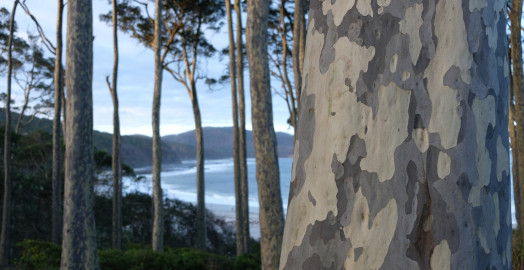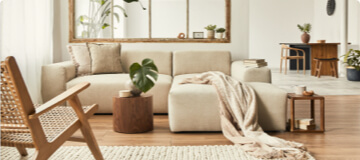There’s nothing quite like a lovely hardwood floor. Durable yet elegant, they’re a wonderful feature piece that can last for decades. One of the most popular is a spotted gum floor, a choice that offers all the toughness of an Aussie hardwood with beautiful and unique characteristics which ensure that no one else will have a floor quite like yours.
If you’ve been swept away by the beauty of a spotted gum floor and are considering one for your home, we’ve put together this handy guide, breaking down just about everything you’ll need to know.
But first, what exactly is spotted gum?
What is spotted gum?

Spotted gum trees (Corymbia maculata) consist of four native Australian species that grow along the east coast from Victoria to Queensland. They get their name from the spots on the tree that become visible as the outer bark layers peel away, as well as from the mottled bark itself.
Spotted gum floors—a uniquely Australian specimen
The timber provided by spotted gum comes in a huge range of rich shades and grain styles. The heartwood is warmer, in shades of light brown to a deep red-brown, while the sapwood leans towards paler shades of white and brown. This means that you’ll have no shortage of choice when it comes to a spotted wood floor, whatever your aesthetic. And as a natural product, no two floors will ever be the same, guaranteeing a truly unique finish.
Hardwood floors are usually split into one of four grades – select, standard, Australiana, and natural (also known as feature grade). Keep an eye on these grades as you search for your perfect timbers, as they give an indication of the number of natural features, like gum veins, grains, and insect trails, that are showcased on the wood. If you’re looking for clean, sleek, and modern, try a select-grade spotted gum. For more of a talking point, you’ll want to seek out those natural/feature-graded timbers.
Spotted gum floors are durable and resilient
One of the main draws of spotted gum floors, other than their beauty, is their durability. One of the hardest of the Australian hardwood trees, they make for incredibly robust flooring. To make the most of their resilience, make sure to plan for the boards to be properly treated and varnished, whether by yourself or by a professional – your floors will thank you in 50 years when they’re still going strong!
The Janka Hardness Scale is an industry-based test used to determine the hardness of timber floors. The test measures the floor’s resistance to pressure, by trying to embed a ball bearing into the surface. The tester will then note how much force it took to do this, and the higher the number, the harder the wood. In Australia, this is measured in kilonewtons (kN), with anything above 8.0kN ranking as particularly strong – spotted gum floors come in at an impressive 11kN.
This means they’re durable, resistant, and less prone to dents. Perfect if you expect there to be a lot of foot traffic, such as kids or pets running around. If you’re looking for something even tougher, bamboo flooring clocked in at a huge 14.7kN – you can find out more about this alternative with our pros and cons guide to bamboo flooring.
Spotted gum floors are also termite, Lyctus Borer, and fire resistant – so much so that they’re approved for use in bushfire-prone areas! In fact, it’s hardy enough to manage most extreme climates but, as with any solid timber flooring, you’ll need to look into the appropriate vapour barriers and underlays to protect your floors if you live in particularly rainy or humid areas. You’ll also need to be mindful of this if you’re planning to install in spaces such as bathrooms or basements.
A sustainable resource
If you’re environmentally conscious, a spotted wood floor is a great option. It’s harvested from both commercial plantations and native forests within Australia. Merbau, another commonly used hardwood, is sometimes brought in from overseas, making its carbon footprint much larger and putting it more at risk of being part of illegal forest clearings. Spotted gum, as a local resource, has less such issues.
The longevity of a spotted gum floor also means it ticks a few more sustainability boxes. When properly cared for, it can last for decades, reducing the need to chop down, transport, treat, and install a whole new floor for quite some time.
Taking care of your spotted gum floor
To make the most of that durability and longevity, you’ll need to take good care of your floors. Happily, because the spotted gum is such a reliant tree, this shouldn’t be too taxing!
Regular sweeping and mopping should do the trick, and you should stay away from any abrasive products. And be sure to clean up any spills or pet accidents right away.
You can enjoy your spotted wood floors for years, though as the wood ages, you might want to consider sanding down and refinishing the planks, just to freshen things up a little.
How much do spotted gum floors cost?
Sustainability, durability, and aesthetics are all well and good, but most of us will likely have one big question on our minds – how much will it cost?
While you’ll have to consider all the usual factors – amount of product needed, the grade you’re looking for, installation and labour costs, etc. – the general rule is that, as a solid timber product, you can expect to pay much more than you would do for a synthetic or engineered style that offers a similar look.
That being said, some may look upon a solid hardwood floor as an investment. Not only will it likely not need replacing for the entire time you’re in your home, but it can potentially add resale value should you choose to move.
Solid timber floor vs engineered flooring
If the cost of a solid timber floor is getting you hot under the collar, turning to engineered spotted wood floors, or even vinyl and laminate alternatives may be an option. These can help you capture that wonderful look and feel without spending quite so much. You might also find them to be a little more pleasant to walk across, with the help of underlays to manage cushioning and sound absorption.
Engineered wood flooring combines a thin layer of hardwood, such as spotted gum, with a substrate of plywood. This gives the aesthetic of the original hardwood, though it won’t last quite as long – expect around 25 years from a well-cared-for engineered floor. That said, it’s a great option if managing moisture in the home is going to be an issue, as it will warp less than solid timber.
If you’d like to know more, check out our breakdown of the pros and cons of both solid timber flooring and engineered flooring.
It’s a similar story with vinyl and laminate flooring, though these only mimic the look of spotted gum – they contain none of the actual hardwood itself. However, advances in technology have come a long way since the introduction of laminate back in the 1970s, and the range of colours and styles available in these flooring types can do a fine job of capturing the unique beauty of a spotted gum floor. Their resilience isn’t on the level of solid wood or even engineered flooring, but in terms of price, they’re a tough one to beat.
It’s also worth noting that both these types of flooring are possible to install yourself, cutting costs on labour as well as materials. Comparatively, solid timber floors are best left to the experts.
So, are spotted gum floors right for you?
If you’re looking for a unique slice of Australiana in your home, it’s hard to go past a spotted gum floor. Ticking all the boxes when it comes to look, durability, and minimal upkeep, they’re a bold and beautiful choice.
Reach out to the experts for a chat and quote and see if you can bring a little bit of Aussie luxury into your living room.
References
- Clem Sturgess, 2021, “The Bold and Varied Styles of Spotted Gum Timber”, Online Flooring Store
- 2021, “Spotted Gum Flooring – Buyers Guide”, FloorVenue
- “Why Spotted Gum Flooring: The Secret Behind Australia’s Favourite Floor”, Lifewood
- “How To Test Timber Floor Durability With The Janka Hardness Rating”, Lifewood





